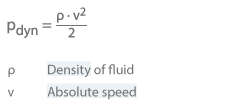Pressure
Pressure is a physical property and specifies the force exerted on a certain unit area. Its symbol is p and unit is Pa (Pascal); however N/m² and bar (fluid) are also commonly used.
In fluid systems, the values and terms defined for pressure are as laid down in DIN 24312 (as an extension of ISO 2944). It is necessary to distinguish between static and dynamic pressure.
Static pressure
Static pressure is pressure which a probe entrained with the fluid would measure (see Pressure measurement).In centrifugal pump technology, the term pressure always refers to a static pressure. In accordance with DIN EN ISO 17769-1, the barometric pressure (pb) and the vapour pressure (pD) of the fluid handled must be specified as absolute pressure, whereas all others must be specified as gauge pressures
(e.g. in relation to barometric pressure). In the case of pressures below atmospheric, the values will be negative ones.
(e.g. in relation to barometric pressure). In the case of pressures below atmospheric, the values will be negative ones.
Overview of the most frequently used static pressures
see Fig. 2 Head
see Fig. 2 Head
- Pressure at inlet cross-section of the pump (ps). Gauge pressure at its elevation (zs)
- Pressure at outlet cross-section of the pump (pd). Gauge pressure at its elevation (zd)
- Pressure in the pressure gauge at the inlet cross-section of the pump (ps,PG). Gauge pressure in the pressure gauge
if the measuring line is filled with liquid:
ps = psM + ρ g zs,M
ρ Density of the fluid in the measuring line
g Acceleration due to gravity
zs,PG Difference between the elevations of the pressure gauge middle and the point of measurement at the inlet cross-section of the pump
g Acceleration due to gravity
zs,PG Difference between the elevations of the pressure gauge middle and the point of measurement at the inlet cross-section of the pump
in an air-filled measuring line:
ps = psM
ps = psM
This also applies to the pressure in the pressure gauge at the pump's outlet cross-section (pdPG).
- Pressure at inlet cross-section of the system (ps).
Gauge pressure at the inlet cross-section (As) at its elevation (zs), i.e. if there is a liquid level present, the gauge pressure at this liquid level - Pressure at outlet cross-section of the system (pd).
Gauge pressure at the outlet cross-section (Ad) at its elevation (zd), i.e. if there is a liquid level present, the gauge pressure at this liquid level - Barometric pressure at pump installation (pb). (See Atmospheric pressure)
- Vapour pressure (vapourisation pressure) of the fluid handled (pV). Absolute pressure at which the fluid handled evaporates at the temperature prevailing at the inlet cross-section of the pump.
Dynamic pressure
Dynamic pressure at a stagnation point corresponds precisely to the increase in static pressure along the stream line (see stream line) as a result of the fluid being brought there to rest.
Dynamic pressure at a stagnation point corresponds precisely to the increase in static pressure along the stream line (see stream line) as a result of the fluid being brought there to rest.
It is therefore also known as "stagnation pressure".

This results in the total pressure (ptot):

